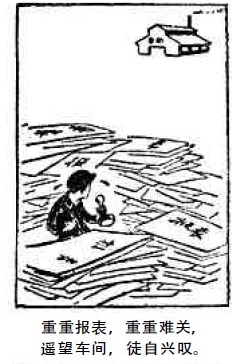Photo Captions
Crises of Counting
 |
 |
In 1950s China, a reliance on complete enumeration through a system of periodic reports had resulted in an explosion of statistical tables at the grassroots level, and little capacity to manage the resultant deluge.
The first panel in this two-panel comic captures that chaos. It shows a worker engulfed by statistical reports, even as he gazes longingly at the factory from which he, and more importantly, his labor, are being kept away. The caption, loosely translated reads, “too many tables, too many difficulties, casting [my] eyes at the distant factory, [I] can only let out a sigh.”
The second panel presents a remarkably different scenario. After a slew of statistical reforms, the chaos has abated. Now the worker strides purposefully toward the factory, the tables compiled and tucked neatly under one arm. No longer is his labor being wasted: “Having streamlined reports and personnel, [and] simplified procedures, [I] head toward the factory.”
This two-panel comic appeared in the 29 April 1958 issue of the People’s Daily. It accompanied a series of articles that dealt with statistical reforms that had recently been introduced in the northern Chinese province of Hebei. Were we to stop our story here, it would end as one of hope and success. It would also render invisible its macabre postscript.
By August of that year, Mao Zedong and China’s leadership initiated the Great Leap Forward (GLF), a nationwide campaign that entailed a far-reaching reorganization of labor and production technologies with the goal of overtaking England and matching the United States in fifteen years. Hebei’s statistical reforms, celebrated in April, were incorporated into the GLF. By 1959, the GLF was a disaster. It also resulted in a famine whose toll remains controversial to this day. The official Chinese estimate is 15 million. The consensus among independent scholars is 30-35 million. The statistical reforms that were initiated in Hebei and subsequently expanded nationwide through the fall of 1958 played no small part in this disaster.
To learn more, I invite you to read my book, Making it Count: Statistics and Statecraft in the Early People’s Republic of China, where I explore this history and the place of statistics in Chinese state-building after 1949.
Arunabh Ghosh
